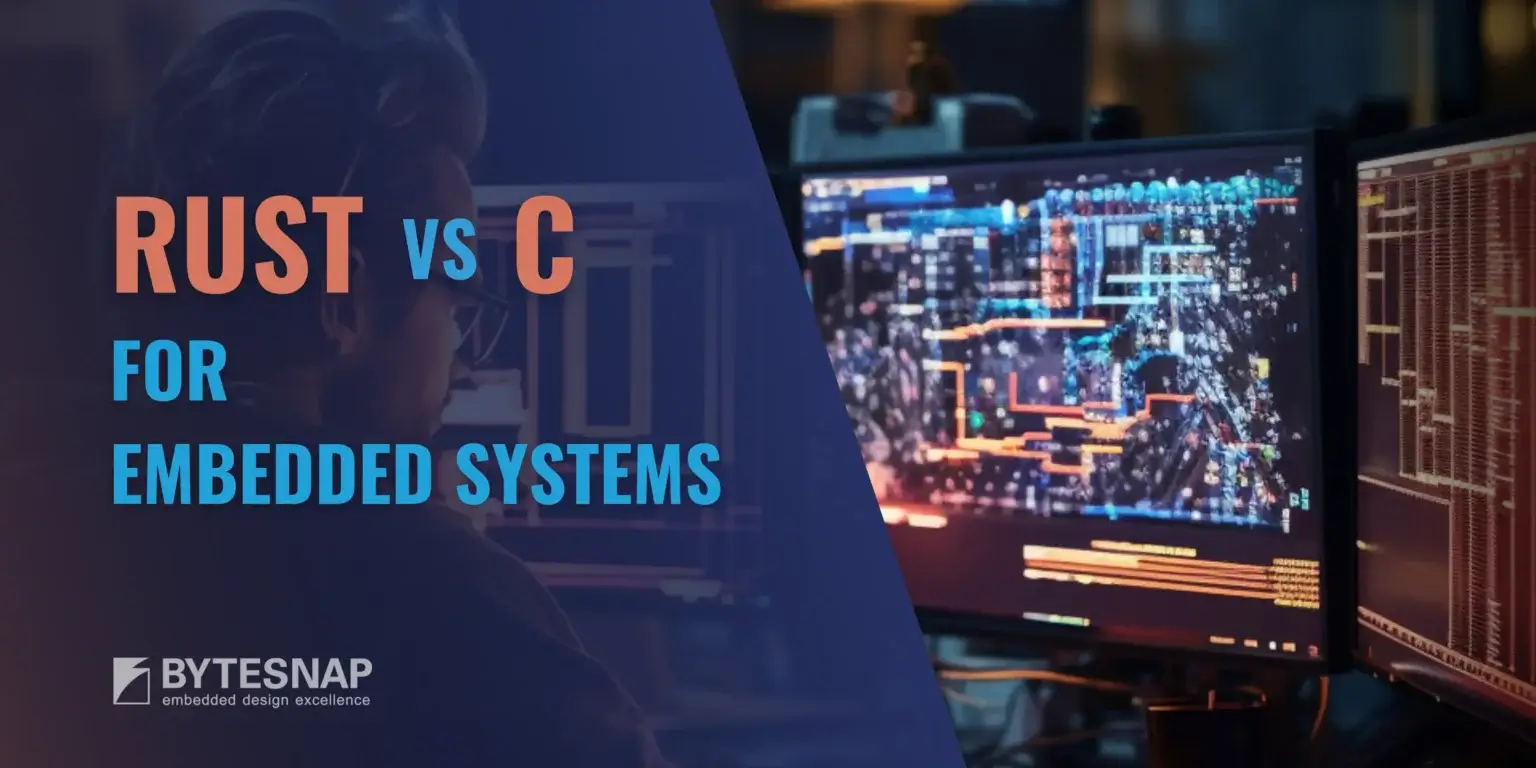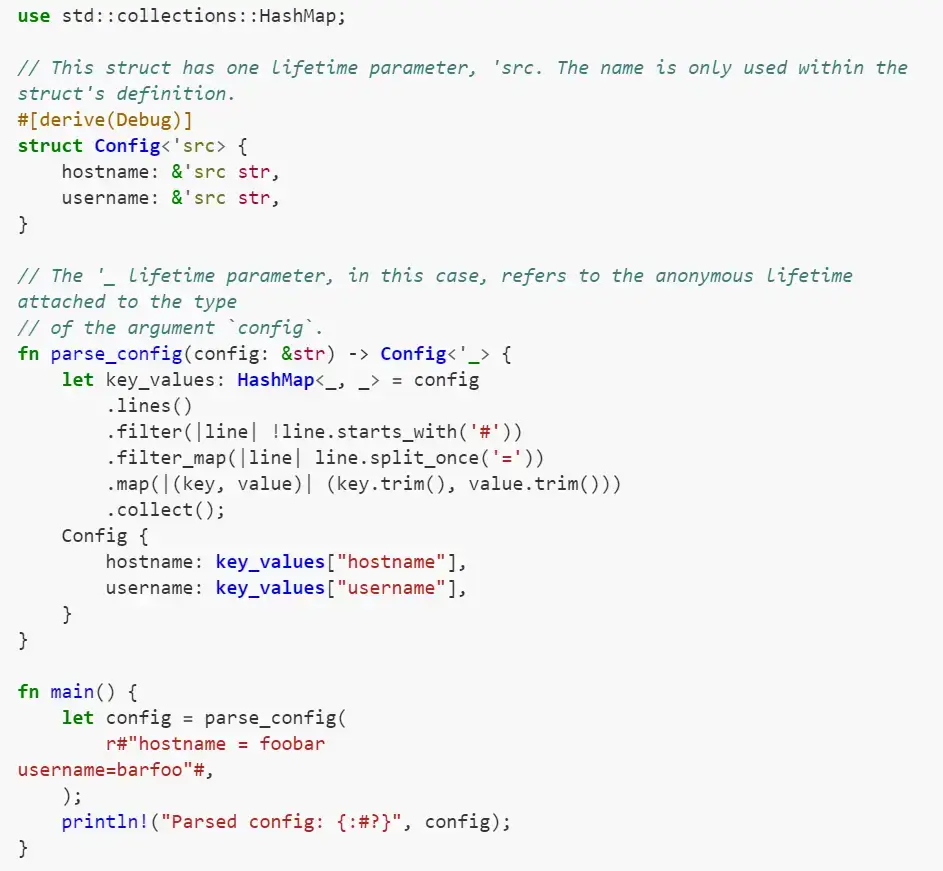Rust vs C - TL;DR:
- The Biden Administration has pushed for the adoption of Rust and other memory-safe programming languages in embedded systems
- C has been the dominant language in embedded systems for decades due to its fine-grained control and extensive ecosystem
- Rust programming language offers
- memory safety and concurrency benefits but comes with challenges such as a learning curve and limited vendor support
- C remains a viable choice for many embedded projects due to its deep roots, predictability, and the availability of skilled developers
- ByteSnap uses a combination of safe coding practices, static analysis, and runtime monitoring to ensure memory safety in C-based embedded software development
- Choosing between Rust and C depends on project requirements, existing codebase, and the need for low-level control

Introduction
Picture this: you’re an embedded software engineer, and you’re hearing all this buzz about memory-safe languages like Rust. The Biden Administration is even pushing for developers to make the switch!
But let’s be real—you’ve been coding in C for as long as you can remember, and it’s got the job done. Is it really worth the hassle of jumping ship to Rust?
As a Director at ByteSnap, I’ve been around the block a few times when it comes to embedded systems programming, with over 30 years in the industry designing embedded software and leading development teams.
Our programmers have shipped hundreds of projects using C, and we know the ins and outs of the language.
But we’re also keeping our finger on the pulse of what’s new and shiny, like Rust.
Here, I’ll give you the lowdown on the Rust programming language vs. C debate, the challenges of making the switch, and some alternative approaches to tackling memory safety.
By the end, you’ll have a clearer picture of whether Rust is right for your next embedded software development project.
The C Dominance in Embedded Systems Programming

Let’s start with the elephant in the room: C has been the go-to language for embedded systems programming for decades, and for good reason.
When you’re working with limited resources, you need that fine-grained control over memory and hardware that the C programming language gives you. Plus, there’s a huge ecosystem of tools, libraries, and frameworks built around C.
And let’s not forget about the massive amount of legacy code out there—rewriting all of that in speedy Rust code would be a nightmare!
However, with the rise of Rust and its popularity among developers on platforms like Stack Overflow, there is a growing debate over its potential to replace C as the dominant language in operating systems, device drivers, and open-source embedded systems programming.
This debate has been fuelled by coders like Steve Klabnik, who have been involved with the Rust programming language since its early days and have seen its potential to revolutionise the field of embedded systems programming with its unique features and capabilities compared to traditional languages like C and Python.
Rust: The 'New' Kid on the Block

But then there’s Rust programming language, with its fancy memory safety features and concurrency support.
Rust’s ownership system and borrow checker catch memory bugs at compile time, which is a big deal for preventing crashes and vulnerabilities.
And Rust’s type system makes it easier to write thread-safe code, which is crucial for modern embedded Linux systems
The Rust community is also growing fast, with several embedded-specific tools and libraries.
As well as the Rust Foundation, there’s the Embedded Working Group, the embedded-hal project, and other initiatives aimed at making Rust more accessible to embedded software engineers.
Background
Rust originated in 2006 as a personal project by Graydon Hoare, a Mozilla Research worker. It evolved under Mozilla until 2021, when the Rust project became the Rust Foundation, with corporate founding members Amazon Web Services, Huawei, Google, Microsoft, and Mozilla.
Shane Miller is a prominent figure in the Rust programming language community, having chaired the foundation’s board and created a Rust team at AWS. His insights into the language highlight its unique advantages and multiple superpowers within a single programming language.
What are the key features of the Rust programming language?
Rust programming language is known for its memory safety, fearless concurrency, and performance.
It offers a modern type system with zero-cost abstractions and guarantees thread safety, making it ideal for systems programming where reliability and efficiency are crucial.
It uses Cargo as its package manager. Through Cargo, developers can easily manage dependencies, run tests, generate documentation, and more.
By default, dependencies are sourced from crates.io, a user-contributed registry where Rust libraries are shared, but developers also have the flexibility to specify dependencies from Git repositories, local filesystems, and other external sources.
This simplifies the process of building and managing projects in Rust while ensuring efficient code development practices.

The Challenges of Rustifying Your Codebase
So, Rust sounds pretty good, right?
Well… not so fast.
Adopting the Rust programming language for embedded systems programming comes with its own set of headaches:
- The Learning Curve: The Rust ownership system and borrow checker can take some getting used to, especially if you’re coming from a C background.
- Ecosystem Maturity: While the Rust embedded ecosystem is growing, it’s still not as mature as the C ecosystem. You might hit some roadblocks when it comes to finding the right tools and libraries for your embedded software development project.
- Integration with Existing Code: If you’ve got a bunch of legacy C code, integrating Rust can be tricky. You’ll need to plan carefully and take a gradual approach to avoid breaking things.
- Vendor Support: Not all embedded systems vendors are on the Rust bandwagon yet. You might have to roll up your sleeves and build your own tooling and libraries if your vendor doesn’t provide official Rust support.
Sticking with C: The Case for the Status Quo
Despite the hype around Rust, there are some compelling reasons to stick with C for your embedded systems programming projects:
Deep Roots:
C has been the backbone of the embedded systems world for decades.
It’s deeply entrenched in the industry, with a vast ecosystem of tools, libraries, and frameworks that have been battle-tested in countless projects.
From tiny microcontrollers to complex industrial control systems, C has been the language of choice for getting the job done. Ripping out all that legacy code and replacing it with Rust would be a colossal undertaking, not to mention the risk of introducing new bugs and compatibility issues.
Unparalleled Vendor Support:
One of the biggest advantages of sticking with C is the unparalleled level of support from silicon vendors and toolchain providers.
Pretty much every embedded processor and microcontroller out there comes with a C compiler and a full suite of C-based development tools.
This widespread support makes it easy to get up and running with C on any platform, and ensures a high degree of portability and compatibility across different hardware architectures.
With C, you know you’ll always have the tools and resources you need to get the job done.
Predictability and Control:
When you’re working on real-time systems with tight resource constraints, you need a language that gives you complete control over what’s happening under the hood.
C is the ultimate language for low-level programming, allowing you to write highly optimised code that squeezes every last bit of performance out of your hardware.
With C, you have fine-grained control over memory allocation, CPU utilisation, and other system resources, making it easier to build systems that meet strict timing and performance requirements.
And because C is a relatively simple language with a small runtime footprint, it’s easier to reason about how your code will behave in a predictable and deterministic way.
Skill Availability and Expertise:
One of the biggest challenges of adopting a new language like Rust is finding developers with the necessary skills and expertise to work with it effectively.
On the other hand, C has been around for decades, and there’s a huge pool of experienced embedded software engineers who know the language inside and out.
This deep well of C expertise is a huge asset for any embedded systems project, making it easier to find qualified developers and get up to speed quickly.
Plus, a lot of the knowledge and best practices around embedded systems programming are closely tied to the C language, so sticking with C allows you to leverage all that accumulated wisdom and experience.

Tackling Memory Safety without Rust
Now, at this point, you’re probably thinking: “But what about memory safety? Isn’t that the whole point of Rust?”
Well, there are other ways to tackle memory safety in embedded systems programming without completely jumping ship to Rust:
- Safe Coding Practices: By following best practices like avoiding dynamic memory allocation and using bounded arrays, you can mitigate a lot of memory-related bugs in C.
- Static Analysis Tools: Static analyzers can catch a lot of memory safety issues at compile time, just like Rust’s borrow checker.
- Runtime Monitoring: Tools like address sanitisers and memory protection units can catch memory bugs at runtime, providing an extra layer of safety.
At ByteSnap, we use a combination of these techniques to keep our C code safe and secure.
We’ve been in the embedded software development industry since 2008, and we’ve delivered hundreds of successful projects for clients all over the world.
Our team has the expertise to write high-quality C code that’s both performant and memory-safe.
Conclusion: Choosing the Right Tool for the Job
So, where does that leave us in the great Rust programming language vs. C debate?
As with most things in engineering, the answer is: it depends.
If you’re starting a new embedded software development project from scratch and memory safety is your top priority, Rust might be worth a look as it solves pain points present in many other languages.
But if you’ve got a lot of existing C code, or if you need the kind of low-level control and predictability that C provides, sticking with C might be the way to go by default.
However, with the rise of Rust’s popularity and its ability to handle low-level tasks, it may be worth considering using it for certain projects, such as an Amazon Web Services implementation or a Rust implementation of a command line tool.
At ByteSnap, we’re always evaluating new technologies to see how they can benefit our clients. While C is still our bread and butter, we’re keeping a close eye on Rust and how it evolves in the embedded Linux space.
Our goal is to use the best tool for the job, whether that’s C, Rust, or something else entirely, especially in our backend software projects.
With Rust’s growing popularity and interest among rust developers, or “Rustaceans,” it’s clear that it will be a valuable tool for many projects in the next year and beyond, making it a promising new language for embedded systems.
Need help with embedded systems development? Let's talk
If you’re looking for a partner to help you navigate the complexities of embedded systems programming, we’d love to chat.
Our team has the expertise to help you make the right choice for your embedded software development project, and to deliver high-quality, reliable embedded systems using the tools and techniques that make sense for you.
At the end of the day, the most important thing is to build embedded systems that are safe, secure, and performant.
Whether you choose Rust, C, or something else, having the right team in your corner, can make all the difference.
So why not give us a shout? Get in touch and Let’s build something great together.

ByteSnap Design co-founder Graeme Wintle is one of the UK’s most experienced Microsoft Windows CE developers and is highly sought after for his expertise in migrating and security operating systems.
After graduating in Software Engineering from Newcastle University, Graeme quickly distinguished himself in software development at Nokia, GST Technology and Intrinsyc.
Graeme has been helping companies around the world with embedded software development for over twenty years. His cutting-edge design work has been instrumental in establishing ByteSnap at the forefront of embedded system design.
Graeme is the inventor of powerful, flexible user interface development framework, SnapUI.




